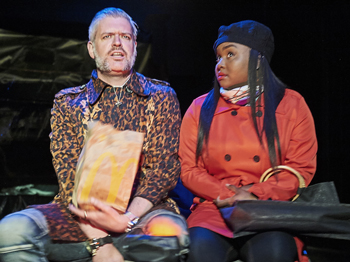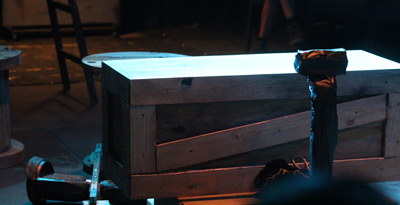
Viewing Pomona's first scene, theatergoers unfamiliar with the plays of Alistair McDowall may have wondered whether the title referred to a tunnel-ride in an amusement park. What else could explain the shabby little go-cart conveying a trio of urban night-owls—an aging-hippie philosopher, his streetwise young companion and, in the back seat, a vaguely-H.P. Lovecraft octopus-faced monster—on a leisurely surveillance patrol of Steep Theatre's storefront auditorium?
Technology-minded playgoers, however, were more curious about the mode of transportation: was it an assisted mobility tricycle, somehow modified to accommodate extra passengers? Was it a pedestal carousel, ordinarily employed for 360-degree displays at trade shows? Was its trajectory controlled by the occupants, or was it autonomously propelled—and, if so, where were the electrical wires, and why didn't they become tangled around the axis of the vehicle's slow orbit?
Since McDowall's script specifies only "a car circles the city," the most reliable solution would be to suggest the cab's interior with two chairs placed side-by-side, but, declares award-winning scenic designer Joe Schermoly, "I was not happy with the idea of starting the play with fifteen minutes of the entire audience watching three people sitting still at one end of the theater."
What alternative did they have, though? Putting the actors in the middle of the stage meant that not everyone would be able to see their faces. Besides, insists Schermoly, the non-linear chronology of the play made it important for the audience to remember those first jarring and disorienting expository scenes. After much discussion among the various Steep Theatre technicians, it was decided that a spinning car would "check all those boxes."

The original plan was for the actor playing the sea-creature to propel the unit with her feet, but after discovering the effort necessary to push the weight of three adults for the required length of time, a hoverboard (once described as a cross between a segway and a skateboard) was added to the structure. "[A hoverboard] is not only dead silent, it's surprisingly powerful." Once some grit was laid down on the floor—thereby increasing the traction—all the stage manager had to do was recharge the battery every night.
How long did it take the actors [Peter Moore and Amber Sallis] to overcome the vertigo induced by rotating in a circle for a quarter of an hour? "The car has a 'dashboard' light mounted at knee level to provide them a fixed spot to focus." Schermoly explains, "This helps them maintain their balance."
Such a Disney-cute contraption could easily become the star of the show (not to mention a must-have Christmas toy). From the beginning, however, Schermoly was careful to guard against such an occurrence. "Audience members have been impressed by how simply and quietly the car works, [but] I don't think the mechanism of a set piece should ever steal the scene. It doesn't even actually resemble a car. The actors, the movement and the lighting—those are the elements that tell us what we're seeing and where we are."
Pomona runs at Steep Theatre through September 14.
Mary Shen Barnidge
Contributing Writer

 Follow Us On Twitter
Follow Us On Twitter